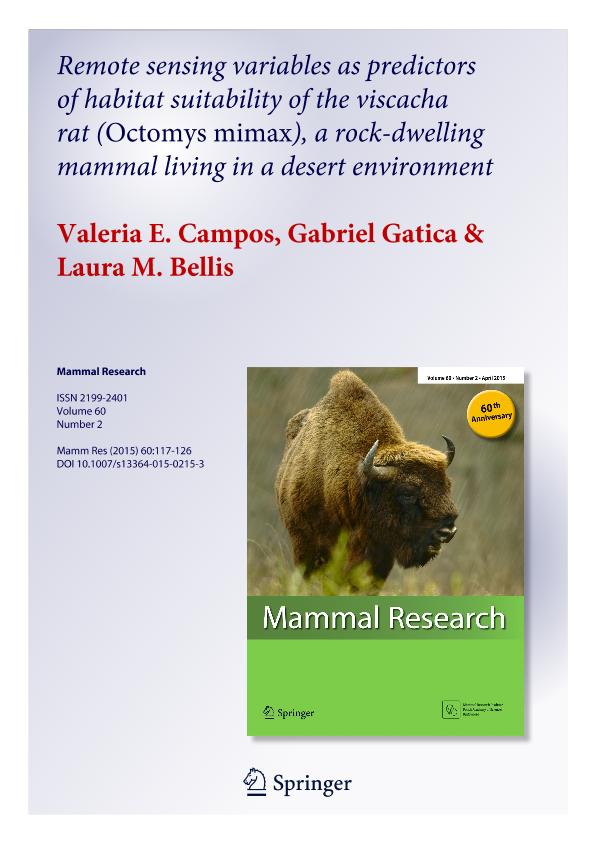Mostrar el registro sencillo del ítem
dc.contributor.author
Campos, Valeria Evelin

dc.contributor.author
Gatica, Mario Gabriel

dc.contributor.author
Bellis, María Laura
dc.date.available
2016-07-22T18:46:18Z
dc.date.issued
2015-04
dc.identifier.citation
Campos, Valeria Evelin; Gatica, Mario Gabriel; Bellis, María Laura; Remote sensing variables as predictors of habitat suitability of the vizcacha rat (Octomys mimax), a rock-dwelling mammal living in a desert environment; Springer; Mammal Research; 60; 2; 4-2015; 117-126
dc.identifier.issn
2199/2401
dc.identifier.uri
http://hdl.handle.net/11336/6641
dc.description.abstract
Identifying high-quality habitats across large areas is a central goal in biodiversity conservation. Remotely sensed data provide the opportunity to study different habitat characteristics (e.g., landscape topography, soil, vegetation cover, climatic factors) that are difficult to identify at high spatial and temporal resolution on the basis of field studies. Our goal was to evaluate the applicability of remotely sensed information as a potential tool for modeling habitat suitability of the viscacha rat (Octomys mimax), a rock-dwelling species that lives in a desert ecosystem.We fitted models considering raw indices (i.e., green indices, Brightness Index (BI) and temperature) and their derived texture measures on locations used by and available for the viscacha rat. The habitat preferences identified in our models are consistent with results of field studies of landscape use by the viscacha rat. Rocky habitats were well differentiated by the second-order contrast of BI, instead of BI only, making an important contribution to the global model by capturing the heterogeneity of the substratum. Furthermore, rocky habitats are able to maintain more vegetation than much of the surrounding desert; hence, their availability might be estimated using SATVI (Soil Adjusted Total Vegetation Index) and its derived texture measures: second-order contrast and entropy. This is the first study that evaluates the usefulness of remotely sensed data for predicting and mapping habitat suitability for a small-bodied rock dwelling species in a desert environment. Our results may contribute to conservation efforts focused on these habitat specialist species by using good predictors of habitat quality.
dc.format
application/pdf
dc.language.iso
eng
dc.publisher
Springer

dc.rights
info:eu-repo/semantics/openAccess
dc.rights.uri
https://creativecommons.org/licenses/by-nc-sa/2.5/ar/
dc.subject
Habitat Selection
dc.subject
Soil Adjusted Total Vegetation Index
dc.subject
Image Texture
dc.subject
Rocky Habitat
dc.subject
Vizcacha Rat
dc.subject
Desert Ecosystem
dc.subject.classification
Ecología

dc.subject.classification
Ciencias Biológicas

dc.subject.classification
CIENCIAS NATURALES Y EXACTAS

dc.title
Remote sensing variables as predictors of habitat suitability of the vizcacha rat (Octomys mimax), a rock-dwelling mammal living in a desert environment
dc.type
info:eu-repo/semantics/article
dc.type
info:ar-repo/semantics/artículo
dc.type
info:eu-repo/semantics/publishedVersion
dc.date.updated
2016-07-22T13:45:11Z
dc.journal.volume
60
dc.journal.number
2
dc.journal.pagination
117-126
dc.journal.pais
Alemania

dc.journal.ciudad
Berlín
dc.description.fil
Fil: Campos, Valeria Evelin. Consejo Nacional de Investigaciones Científicas y Técnicas. Centro Científico Tecnológico San Juan. Centro de Investigaciones de la Geosfera y Biosfera; Argentina. Universidad Nacional de San Juan. Interacciones Biológicas del Desierto; Argentina
dc.description.fil
Fil: Gatica, Mario Gabriel. Universidad Nacional de San Juan. Facultad de Ciencias Exactas, Fisicas y Naturales. Instituto y Museo de Ciencias Naturales; Argentina. Consejo Nacional de Investigaciones Cientificas y Tecnicas. Centro Cientifico Tecnologico San Juan; Argentina
dc.description.fil
Fil: Bellis, María Laura. Consejo Nacional de Investigaciones Cientificas y Tecnicas. Centro Cientifico Tecnologico Cordoba. Instituto de Diversidad y Ecologia Animal; Argentina
dc.journal.title
Mammal Research
dc.relation.alternativeid
info:eu-repo/semantics/altIdentifier/url/http://link.springer.com/article/10.1007/s13364-015-0215-3
dc.relation.alternativeid
info:eu-repo/semantics/altIdentifier/doi/10.1007/s13364-015-0215-3
dc.relation.alternativeid
info:eu-repo/semantics/altIdentifier/doi/http://dx.doi.org/10.1007/s13364-015-0215-3
Archivos asociados
